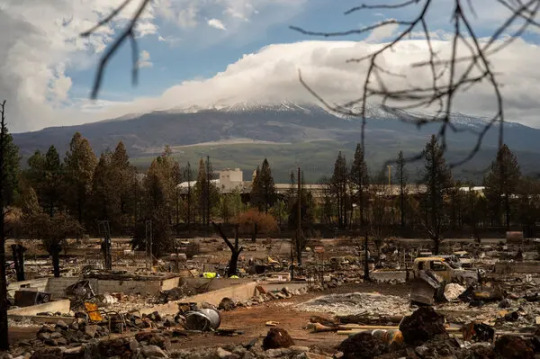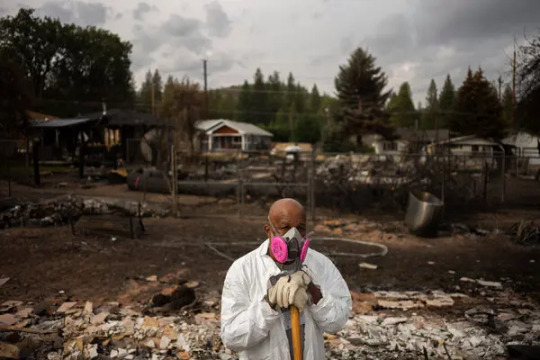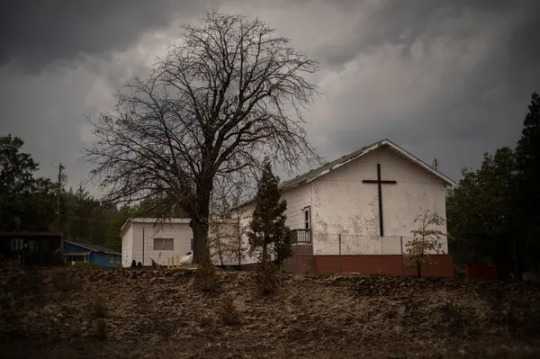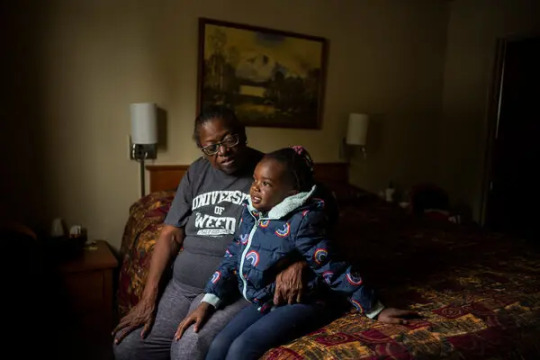#Wildfire Destroys a Piece of Black History in Rural California
Text
The Lincoln Heights community endured for decades, despite segregation, economic hardship and a pandemic. Then came the Mill fire.
When the Mill fire ripped through Weed, Calif., just before Labor Day weekend, the hardest-hit area was a historically Black neighborhood that dates back nearly a century.Credit...Brian L. Frank for The New York Times
Oct. 7, 2022
WEED, Calif. — The gray rubble appears suddenly on both sides of the highway winding through this small Northern California town, as houses give way to a landscape of charred wreckage and the remains of homes, bleached white by wildfire.

The devastation stretches for blocks. Metal skeletons of cars and blackened trees indicate where properties once stood in the shadow of Mount Shasta.
This neighborhood, Lincoln Heights, was once the thriving and vibrant home of a Black community — a rare sight in predominantly white, rural Siskiyou County, which hugs the Oregon border. Black laborers moved here from Louisiana, Mississippi and Arkansas to work at a lumber mill in the 1920s, and their descendants continued to live in houses on the outskirts of town, passed down through generations.
For decades, the mill next to Lincoln Heights offered opportunity and hope for those seeking a job and a better life. Now, residents see it as a symbol of the neighborhood’s destruction. Roseburg Forest Products, the mill’s owner, has said it is investigating whether hot ash in its facility started the Mill fire, which ripped through Lincoln Heights before exploding to 4,000 acres in early September.
In Weed, the Mill fire consumed most of Lincoln Heights, killing two people and destroying nearly 60 homes. The park that served as a gathering place is all that remains of the eastern side of the neighborhood.
“You can build that house back. But that home is a most special place,” said Andrew Greene, 84, who raised his children in Lincoln Heights. “It’s a place of culture, it’s a place of growth, it’s a place of remembrance and most of all it’s a place of love.”

The rapid blaze was the latest in a series of fires in California that, as the climate warms, have leveled neighborhoods like Coffey Park in Santa Rosa, or towns like Paradise and Greenville. That devastation has forced wildfire victims to choose between rebuilding or starting life anew elsewhere.

The hints of life from before the fire are few in Lincoln Heights. A child’s bicycle abandoned on the side of the road. A pocket watch peeking through debris. At one property, atop porch steps that lead nowhere, sits a vase of fresh flowers as a memorial.
Many residents have pledged to rebuild. But they worry that enough of their neighbors will flee to other cities for the spirit of the old neighborhood to be lost for good.
In the 1920s, hundreds of Black Southerners made the journey to rural Northern California, lured by the promise of employment, for $3.60 a day, at the sawmill owned by the Long-Bell Lumber Company, which had just closed two mills in Louisiana as it searched for untouched forests out west.
The company lent workers the train fare and provided them with wooden houses amid the aspens and pines in a small place called Weed. It was a company-owned, segregated town, and Black mill workers and their families were required to live on the northern outskirts. That neighborhood was known as the Quarters and, later, Lincoln Heights.
For decades, Black residents of Weed had their own church, barbershops and nightclubs, according to residents and a 2011 documentary about the neighborhood’s history produced by Mark Oliver, a filmmaker. They were prohibited from being buried in the white-only graveyard, so they had to dig their own. Black people could shop in some white-owned stores and cafes, but they couldn’t linger.
“Your parents would buy you an ice cream cone, you had to go outside to eat it — you couldn’t use the counter,” recalled Al Bearden, a retired probation officer who grew up in Weed.
At the sawmill, white workers were given safer, more lucrative jobs indoors. The only integration came at school — where white and Black children learned together before returning to their cloistered communities — and on the Weed Sons, the town’s baseball team.
That began to change in the 1950s and 1960s, when the civil rights movement slowly arrived in Siskiyou County. In Weed, Black residents arranged sit-ins at restaurants that wouldn’t serve them and boycotted businesses until they agreed to hire them.
Black residents said they still faced discrimination in subsequent years. At school, they said, white children would use racial slurs and make fun of those who had less money.

Lincoln Heights residents said theirs was the kind of neighborhood where children who were spotted misbehaving by a local elder could expect a call to their family home that evening. On Sundays, the Mt. Shasta Baptist Church was full.

The center of social life was 13-acre Charlie Byrd Park, named after the first elected Black sheriff in California, who grew up in Weed and led Siskiyou County’s law enforcement agency for 16 years.
“On the weekends, that was always packed,” said Lawrence Robison, 39, who grew up in the neighborhood. “Family gatherings, barbecues — just a place to go and relax at the end of the day.”
At work, times were getting tougher.
In 1982, the International Paper Company, which had succeeded Long-Bell, sold the sawmill to Roseburg Forest Products, a transaction that residents mark as the beginning of the decline of the local logging business. Around that time, advances in automation and a growing environmental movement curtailed lumber jobs.

Some found other lines of work, at the local community college, the water bottling plant and restaurants, or in nearby towns. But others left the region entirely. In 2020, nearly a third of Weed households lived below the poverty line, according to census data.

As longtime Lincoln Heights residents moved to bigger cities, Mexican, Laotian, Filipino and white families took their place. Members of the younger generations said it is now much more common to see people with different racial and economic backgrounds mingling than it was when their parents were children.
“It was a change, but it was a good change,” said Angel Whatley, 24, who grew up in Lincoln Heights.
Weed likes to present its diversity as a success story. Mayor Kim Greene, who is white, calls the city “the melting pot for all the nationalities.”
The city accounts for 6 percent of the population in Siskiyou County, but has 36 percent of the county’s Black residents, based on 2020 census data. It also has a higher share of Hispanic and Asian American residents than the county as a whole.
Still, Black residents say the decades-old struggle for fair treatment continues. Mayor Pro Tem Stacey Green, who is Black, said racism in Weed is “sneaky.”
“It’s behind your back,” he said.
Mr. Green said the city didn’t repave a road in Lincoln Heights until he threatened to call the National Urban League, a civil rights group, while a new street sweeper never made an appearance in the neighborhood until he complained.
The city manager, Tim Rundel, said he understood how Mr. Green and some residents might feel. But, he said, narrow streets in the old neighborhood have made it challenging for street sweepers and snowplows to navigate around parked cars. “It’s been a struggle in Lincoln Heights and other neighborhoods throughout Weed,” he said.
More than 250 miles north of San Francisco, Siskiyou County is still a place where residents scorn the state’s Democratic leadership. Though Weed is more liberal than Siskiyou County as a whole, some Lincoln Heights residents say the presidency of Donald J. Trump deepened political and racial tensions in town.
On the surface, people in Weed “still get along quite well,” Andrew Greene said. But he takes pains to avoid topics that could cause tempers to flare.

“The two rules of the bar — two things you don’t discuss or you shouldn’t discuss: One is politics, the other is religion,” Mr. Greene said.

In the early afternoon of Sept. 2, Weed was sweltering as California braced for the beginning of a record heat wave. Fierce wind gusts brought some relief, but also threatened to send flames and embers flying.
Just before 1 p.m., Pastor Alonzo Greene, Andrew’s son, was standing on the front porch of his childhood home in Lincoln Heights with his wife, smiling proudly because his adult children had just finished moving into the old wooden house his grandparents had built.
Down the block, his father was sitting down for lunch. Suddenly, he heard frantic knocking on his door. “Fire,” his neighbor gasped out.
Then they heard a boom.
In what felt like an instant, the neighborhood was engulfed in smoke, and the billowing winds sent flames from the direction of the mill into the neighborhood.
The younger Mr. Greene plunged into the smoke, kicking in neighbors’ doors and hauling children, pets and seniors into his pickup truck. His father rushed a neighbor and the child she was babysitting into his own truck and started driving blindly through the haze, trusting his memory of the road to guide them to safety.
A few blocks away, Patricia Mitchell’s phone was ringing. It was her sister, asking about the smoke nearby.

“So I got up and went, ‘Well, I don’t see nothing,’” recalled Ms. Mitchell, 68. “The next thing I know, there’s black smoke everywhere.”

She escaped, but her house and all of her possessions — including her wedding ring and coin collection — were gone.
“Every time I think about this fire, it brings me down, because so much was lost,” she said.
Mr. Green, the mayor pro tem, was also in trouble. He rushed out of his house without shoes, into the thick smoke.
“I couldn’t see any skies, and it started getting into my lungs,” he recalled. “I thought, ‘I’m going to die right now.’”
Finally, he saw a glimmer of blue above him and made it to safety.
“My life started there: My first tricycle ride was down my driveway, my first birthday party. And everything I knew was all there — pictures of my parents on the wall. I don’t have none of that left,” Mr. Green said, choking up.
Not everyone in Lincoln Heights survived. Two women, Marilyn Hilliard, 73, and Lorenza Glover, 65, died in the fire. Three others, including Ms. Hilliard’s husband, were injured.
At least three lawsuits have been filed against Roseburg, including a wrongful-death suit by Ms. Glover’s son that says she died as she tried to escape the flames. Ms. Hilliard died of a heart attack during the fire, residents said.
Roseburg officials said the company will provide $50 million for a “community restoration fund,” but that the money is not an admission of liability.
“We’re committed to doing the right thing for Weed, for Lake Shastina, for the long haul,” said Pete Hillan, a Roseburg spokesman.
Mr. Green wasn’t satisfied. “You’re trying to give $50 million to shut our mouths,” he said.
In the weeks since the fire, Lincoln Heights residents have scattered to nearby towns, staying with relatives, filling motels and finding temporary housing. Not everyone plans to return. Many lack the money or insurance to rebuild.
“I’ll move on — I’ll move to L.A.,” said R.T. Smith, who lost his house and all his possessions in the fire. “I’m about tired of this little town,” he added.
Others hope to restore the community. In mid-September, several dozen displaced residents were staying at the Hi-Lo Motel in Weed, where Alonzo Greene led them in a brief prayer twice a day.
“If I broke down and started crying, it really shook all of these people,” he said. “So I had to get to a point where I just take a drive by myself if I want to cry, because I couldn’t let them see it.”
He paused for a moment, gathering himself. “It’s been tough.”
#Wildfire Destroys a Piece of Black History in Rural California#Mill Fire#Weed Fire#Black California#Fires#Climate Change#climate refugees#Mt.Shasta#Lincoln Heights
8 notes
·
View notes